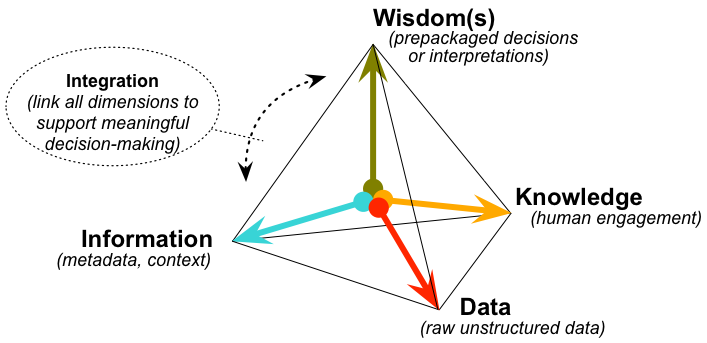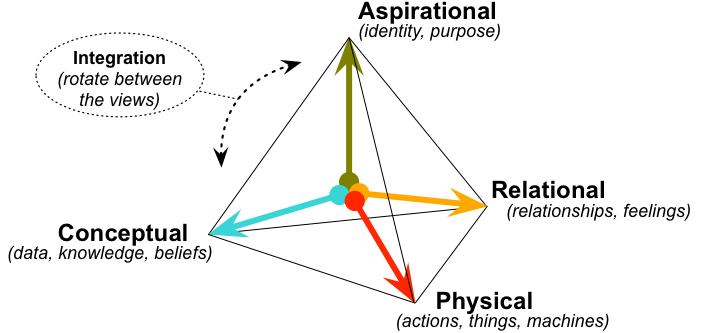What is knowledge?
What is knowledge? And what is its relation with data and information – or wisdom, for that matter?
The starting-point for this was a question on LinkedIn from Josef Miklos, over in the Czech Republic:
I am struggling with the nature of “knowledge” … Do you consider knowledge as a virtual asset? Thanks for any hints!
My short-answer on that, as I replied to Josef, would be that knowledge is information made personal – information that we ourselves can then put to practical use. Josef then wrote back:
Yes, that makes sense. It is nothing special, just a piece of information, that can be actionable. (The value is in the use of it and it depends if the resulted action is effective). The personality aspect is what makes knowledge transfer a problem. That way I can say: knowledge is information applied within the action, which leads as a whole to goal achievement. That leads me to question whether that knowledge can exist without action. Probably yes, and before using it has just proposition of the value.
All of which in turn makes sense to me. It does seem, though, that I need to expand on this a bit – take it a bit further, a bit deeper. The crucial point here is that knowledge is often presented as being one stage or level within a kind of hierarchy or stack:
data -> information -> knowledge -> wisdom
…with ‘wisdom’ as the end-point of the hierarchy, the pinnacle of the pyramid, the top of the stack. Yet as I wrote back in 2012, in my post ‘Rethinking the DIKW hierarchy‘, this construct doesn’t actually make much sense as a linear sequence or stack: for example, we have many supposed ‘wisdoms’ – such as proverbs, or ‘the moral of the tale’, or even our so-called ‘best practices’ – that are of little practical use until we can find a suitable context for which they would fit. Instead, the relationships between data, information, knowledge and wisdom actually make more sense as discrete, distinct dimensions denoting and delineating a kind of ‘knowledge-space’:
…which in turn lines up quite well with the tetradian asset-dimensions:
…which would then give us a correlation or cross-reference somewhat like this:
- Data: the content (often, or even usually, about something tangible) that underpins the meaning
- Information: the context-frame or conceptual schema within which content could be placed
- Knowledge: the connections that link items and context in relations with each other, and in personal use
- Wisdom: an overlay of abstractions to give guidance on purpose or meaning, in terms of aim or aspiration
If so, then yes, the supposed ‘stack’ is indeed one way to make sense of the relationships between that set of dimensions: raw data is placed within a schema, as information, which is then put to practical use as knowledge, and from which abstractions about ‘wisdom’ can be derived. Yet that’s only one amongst many possible pathways through that dimensional space – and others amongst the full set of possible pathways can imply a swathe of real-world oddities and antipatterns that can create all manner of unexpected ‘gotchas’ or potential sources for failure. For example
- ‘body-knowledge‘ represents raw real-world data that has been acquired, built into a personal schema (personal information), underpins personal skill and usage (personal knowledge) and may even represent personal best-practices (personal wisdom) – yet cannot be transferred directly to anyone else, and may also be different from that of anyone else
- a CRM (Customer Relationship Management system) may represent raw-data about past relationships with people, processed into a schema, and used to derive ‘best-practices’ (‘wisdom’) – yet may be worse-than-meaningless wherever it does not relate to present real-world data about that relationship
- a ‘knowledge-base‘ represents real-world data linking to personal use (knowledge) and abstractions from shared-practice (wisdom) – yet may be meaningless outside of the exact context (schema for information) from which it was derived
- raw-data are the basis for everything related to knowledge and the like – yet are essentially meaningless without some kind of schema and metadata to provide context and a framework for interpretation
- principles provide practical ‘wisdoms’ for practical use – yet are essentially meaningless without real-world context and real-world raw-data
In that sense, the notion of ‘knowledge’ can be a lot trickier than it looks. In English, for example, we might say “I know that”, when what we mean is “I have that information” – which is very different from “I know what that information means”, or “I know how to use that information in my own real-world practice”. At all times, and in all contexts, we need to be clear as to what we mean by data, information, knowledge and wisdom – and don’t mix them up!


Hi,
If you get a chance, read the paper by Russell Ackoff:
https://ackoffcenter.blogs.com/ackoff_center_weblog/2006/05/moving_up_the_w.html
Also his video on YouTube
https://www.youtube.com/watch?v=MzS5V5-0VsA
I can see most of this, Tom. The part I am still wrestling with is where Action fits in. Is it its own layer of meaning? A form of meta language…?
Thanks, Mike.
You’re right, Action isn’t there. The classic DIKW (Data, Information, Knowledge, Wisdom) categorisation/argument is primarily/solely about content – categories of ‘thing’. Because of that focus on ‘thingness’, there’s no place within that discussion itself for exploring how such ‘things’ are created, read, updated, deleted – all the Actions that apply to such ‘things’. In general the necessary discussions about those Actions are considered to be a separate matter – arguably they shouldn’t, but that’s what’s usually done, and I stuck to that convention for this post. (If we were talking about architecture, rather than just the DIKW argument, then yes, I would definitely need to include Action – hence, for example, that old post ‘CRUD, CRUDE and other action-acronyms‘, http://weblog.tetradian.com/2013/12/31/crud-crude-action-acronyms/ .)
Action can be modeled as the history of change over all 4 dimensions – time’s arrow.
Which is why I like GraphDBs / 6NF with historicisation to represent
What a pile of baloney! knowledge is not a human invention, not any more than Oxygen is a human invention. Everything in the universe has knowledge and experience, The anthropocentric view is closed vision. Everything learns and builds knowledge. Spiders, ants and bees are brilliant and know so much.
What is knowledge ? Knowledge is the structure of reality. It is a universal, cosmic, phenomenon, like entropy, transformation, time, space, light. Knowledge has its own natural principles and architecture.
Humans, like everything else, tap into this phenomenon and evolved to use it, just like lungs developed to take advantage of the Oxygen phenomenon, the eyes for the light phenomenon, legs for the gravity phenomenon on ground, etc.
Data is computer representation and one can have information data, or knowledge data if one understands knowledge well enough to represent it adequately to systems and computers.
Intelligence is the ability to process knowledge.
Wisdom is a qualification of knowledge on knowledge.
Information is the the most basic and least significant component of knowledge. “25” is information, the fact that it is “the age in earth-years of Jane Doe who just graduated in science of a great university in a East-Asian socialist country …” is knowledge.
Hence, knowledge is information on information on information, with all qualified relationships between all the information, relationships and correlations.
The anthropocentric understanding of knowledge is a vague human fantasy pouring out of ignorance and an anthropocentric viewpoint.
Quote: “What a pile of baloney!” – wow, what a great way to engage in a professional-level discussion, Andre! 🙁 Your choice to engage that way, of course.
Beyond that, no comment, other than to point out that your model of knowledge seems to have no anchor in anything other than personal opinion, and in many ways is a perfect illustration of my point about what happens when the dimensionality of the respective context-space is ignored. Under the circumstances, though I see no point in attempting to explain any of that to you. Oh well.
As Tom points out, the data -> information -> knowledge -> wisdom order needs to be rejected. “Data emerges last—only after there is knowledge and information available… Data can emerge only if a meaning structure, or semantics, is first fixed” (Tuomi, 1999).
However, the tetradian model brings about other problems. Concepts like “integration” and “context” are not very well-defined. Also, as pointed out in a comment, action is not included.
An alternative approach is to depart form the position that all knowledge is personal (Polanyi, M., 1975: Personal knowledge). The constitution of knowledge requires interaction with the environment.
Integration in this approach means that the individual facing a particular situation, integrates previous experiences, physical sensations from the environment, motivation, and emotions into a holistic Gestalt, informing the individual about the situation. This leads to a decision of how to act, an anticipation of the outcome, and execution of the action. The result is then back-propagated and evaluated against the expected outcome. If not positive, a new action cycle begins until the outcome is acceptable.
This also means that concepts like ‘explicit’, ‘common’, or ‘shared’ knowledge are meaningless. What is explicit, common, or shared are social elements in the environment, contributing to the individual constitution of knowledge, information, and meaning.